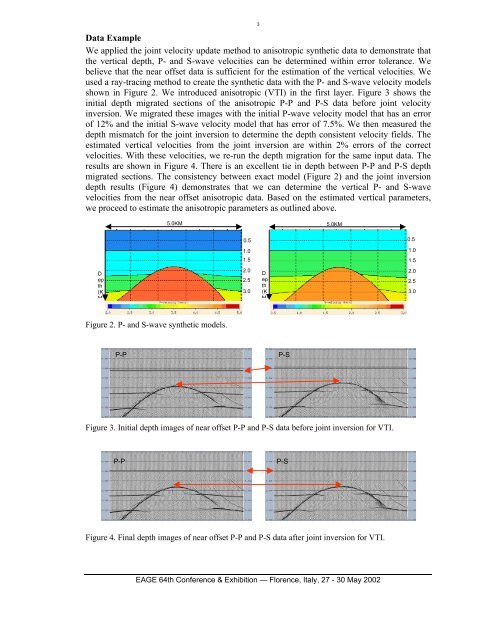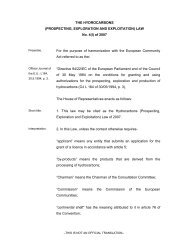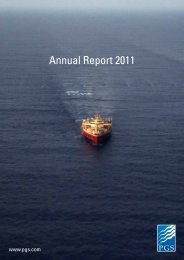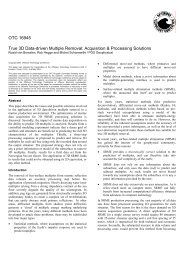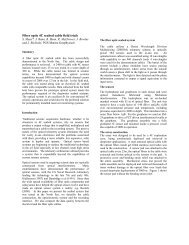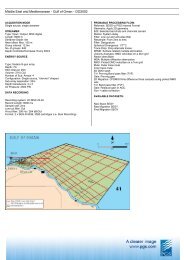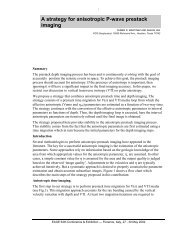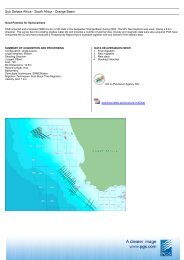joint velocity inversion for pp and ps prestack depth imaging - PGS
joint velocity inversion for pp and ps prestack depth imaging - PGS
joint velocity inversion for pp and ps prestack depth imaging - PGS
You also want an ePaper? Increase the reach of your titles
YUMPU automatically turns print PDFs into web optimized ePapers that Google loves.
3<br />
Data Example<br />
We a<strong>pp</strong>lied the <strong>joint</strong> <strong>velocity</strong> update method to anisotropic synthetic data to demonstrate that<br />
the vertical <strong>depth</strong>, P- <strong>and</strong> S-wave velocities can be determined within error tolerance. We<br />
believe that the near offset data is sufficient <strong>for</strong> the estimation of the vertical velocities. We<br />
used a ray-tracing method to create the synthetic data with the P- <strong>and</strong> S-wave <strong>velocity</strong> models<br />
shown in Figure 2. We introduced anisotropic (VTI) in the first layer. Figure 3 shows the<br />
initial <strong>depth</strong> migrated sections of the anisotropic P-P <strong>and</strong> P-S data be<strong>for</strong>e <strong>joint</strong> <strong>velocity</strong><br />
<strong>inversion</strong>. We migrated these images with the initial P-wave <strong>velocity</strong> model that has an error<br />
of 12% <strong>and</strong> the initial S-wave <strong>velocity</strong> model that has error of 7.5%. We then measured the<br />
<strong>depth</strong> mismatch <strong>for</strong> the <strong>joint</strong> <strong>inversion</strong> to determine the <strong>depth</strong> consistent <strong>velocity</strong> fields. The<br />
estimated vertical velocities from the <strong>joint</strong> <strong>inversion</strong> are within 2% errors of the correct<br />
velocities. With these velocities, we re-run the <strong>depth</strong> migration <strong>for</strong> the same input data. The<br />
results are shown in Figure 4. There is an excellent tie in <strong>depth</strong> between P-P <strong>and</strong> P-S <strong>depth</strong><br />
migrated sections. The consistency between exact model (Figure 2) <strong>and</strong> the <strong>joint</strong> <strong>inversion</strong><br />
<strong>depth</strong> results (Figure 4) demonstrates that we can determine the vertical P- <strong>and</strong> S-wave<br />
velocities from the near offset anisotropic data. Based on the estimated vertical parameters,<br />
we proceed to estimate the anisotropic parameters as outlined above.<br />
5.0KM<br />
5.0KM<br />
0.5<br />
0.5<br />
1.0<br />
1.0<br />
1.5<br />
1.5<br />
D<br />
ep<br />
th<br />
(K<br />
M)<br />
2.0<br />
2.5<br />
3.0<br />
D<br />
ep<br />
th<br />
(K<br />
M)<br />
2.0<br />
2.5<br />
3.0<br />
Figure 2. P- <strong>and</strong> S-wave synthetic models.<br />
P-P<br />
P-S<br />
Figure 3. Initial <strong>depth</strong> images of near offset P-P <strong>and</strong> P-S data be<strong>for</strong>e <strong>joint</strong> <strong>inversion</strong> <strong>for</strong> VTI.<br />
P-P<br />
P-S<br />
Figure 4. Final <strong>depth</strong> images of near offset P-P <strong>and</strong> P-S data after <strong>joint</strong> <strong>inversion</strong> <strong>for</strong> VTI.<br />
EAGE 64th Conference & Exhibition — Florence, Italy, 27 - 30 May 2002


